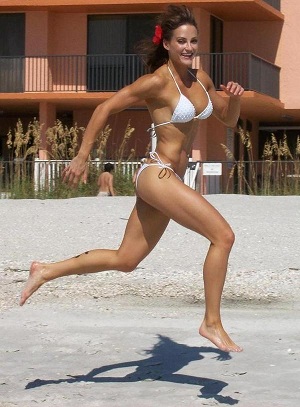Okay, so you’ve met a girl who is no longer skeptical and is willing to train, but now you need to give her quality advice as she starts a new program. Teaching and coaching are dependent on taking complex concepts and whittle them down to easy-to-implement points of emphasis. I have a few topics that we’ll cover in following “70’s Big Women” posts on Monday. Today’s focuses on setting up the new trainee on a quality program.
I’m not so egotistical that people need to do my exact program, nor am I even going to require that all girls primarily strength train. My only requests are:
– squat twice a week
– bench and press once a week each
– do a horizontal and vertical pulling movement once a week each
– do RDL’s twice a week OR RDL and deadlift once a week each
– cardio (low or high intensity) should be kept to training days or Saturday
I’m not really concerned with deadlifts, especially in the first few months of training. The RDL is a movement that works similar musculature as the deadlift, yet is easier to do and will really help develop the hamstrings. I see so many people doing deadlifts incorrectly — male or female — that having a few months of the lumbar holding its position while the hamstrings do work is going to set them up for success if/when they do start deadlifting. Not to mention the hamstrings will develop a wonderful back side on a girl who hasn’t trained before.
I’m also not concerned with what type of squat she does. Let’s face it, not every girl who is training has access to even a decent coach. Then, the low bar back squat is pretty technical compared to the high bar, so this means there are fewer coaches available to teach this movement well. If she’s shoving her knees out and going down all the way, this is a victory. Making it an easier movement (so she isn’t frustrated) is even better. Besides, the RDL’s compliment high bar squats very well.
The inclusion of benching and pressing is obvious — they help develop strength in the upper body. However, extra care should be taken to not allow the new female trainee to internally rotate and flair the elbows. An “elbows to boobs” cue works very well in both of these cases as it will help keep the elbows in, which is an externally rotated position in the shoulder. See this video for a more detailed discussion.
The vertical pulling movement implies pull-ups, chin-ups, or some variation of them. Getting girls, especially taller ones, to do a pull-up can be quite a process. Most girls reflect that ‘greasing the groove’ over time is what helps them best. Chicks who are adamant about developing a pull-up can get a doorway pull-up bar and work on it over time by doing partial reps or negatives (controlling from top to bottom). They can aim for a small amount each day, and increase the reps per day each week. The horizontal rowing movement would imply barbell, dumbbell or machine rows. Most girls — especially those who haven’t trained before — will not have developed musculature in their upper back. This lack of strength and musculature can make it difficult to externally rotate and maintain positioning on the presses, keep the chest up on the squat or deadlift, and become a long-term muscle imbalance over time if not addressed. The sooner the upper back musculature gets developed, the less of a limiting factor it will be.
If the girl is intimidated by or too weak for barbells, she could use machines for the two presses and two rowing movements. However, squatting needs to be done with a bar — hopefully her ‘sponsor’ can articulate how her ass won’t be sweet if she is leg pressing. RDL’s can be done easily enough with the fixed barbells located in most globo gyms, but they can also be picked up from the hooks on the outside of a rack. After a month or so of machine work, our new trainee could transition into using barbells.
This kind of set up could have her training two or three times a week, but preferably three. It’s best to have complete rest days to allow the body to recover and adapt to this new stress.This concept is lost on a lot of new trainees (and folks who come from a conditioning-only background), but hopefully the sponsor can explain how the structures and hormones need this day to undergo cellular change and adaptation. If nobody knows what the hell that means (sponsor or trainee), it at least sounds good and is true. This means that non-strength work (like cardio or any derivative of endurance work) should occur on existing training days so that it doesn’t interfere with recovery.
Next Monday we’ll talk about “cardio” and how it applies to the new trainee. For more information on progressions, templates, and programming, be sure to check out FIT.




